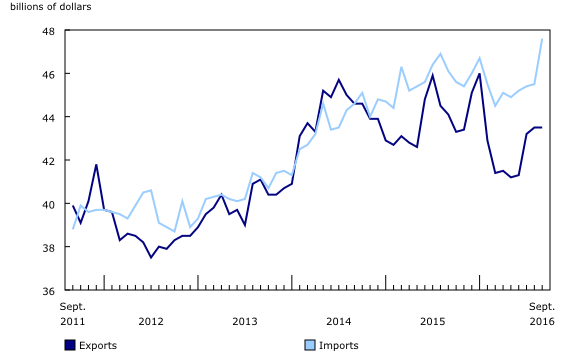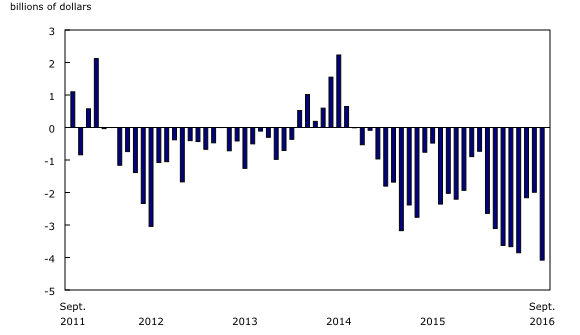Canadian international merchandise trade, September 2016
Archived Content
Information identified as archived is provided for reference, research or recordkeeping purposes. It is not subject to the Government of Canada Web Standards and has not been altered or updated since it was archived. Please "contact us" to request a format other than those available.
Released: 2016-11-04
Canada's imports rose 4.7% to a record $47.6 billion in September, as an exceptionally large transaction accounted for the increase. Import prices increased 2.4% and volumes were up 2.3%. Exports edged up 0.1% to $43.5 billion, as a 0.9% increase in prices was mostly offset by a 0.8% decrease in volumes. Consequently, Canada's merchandise trade deficit with the world widened from $2.0 billion in August to a record $4.1 billion in September.
Following a 4.7% decline in the second quarter, exports rose 5.0% to $130.3 billion in the third quarter, the strongest increase since the first quarter of 2014. Imports increased 2.4% to $138.5 billion. Consequently, Canada's quarterly trade deficit with the world narrowed from a record $11.1 billion in the second quarter to $8.2 billion in the third quarter.
High-value import transaction in September
The overall rise in imports in September was due to an increase in industrial machinery, equipment and parts. Following eight consecutive monthly decreases, imports for this section rose 71.4% to a record $6.9 billion in September. The gain was attributable to one large import of a module from South Korea destined for the Hebron offshore oil project in Newfoundland and Labrador. No additional high-value import transactions are expected for this project. Excluding the $2.9 billion change in imports of industrial machinery, equipment and parts in September, total imports would have decreased 1.6%, resulting in a trade deficit of $1.2 billion.
Trade with non-US countries increases
Imports from countries other than the United States rose 15.9% to a record $18.0 billion in September. The main contributor was South Korea, up $2.9 billion to $3.4 billion, reflecting the large shipment intended for the Hebron offshore oil project. Lower imports from the United Kingdom (-$171 million), Algeria (-$126 million) and Saudi Arabia (-$122 million) partially offset the overall increase.
Exports to countries other than the United States were up 2.3% to $11.2 billion in September. Higher exports to the United Kingdom (+$175 million) and India (+$147 million) were partially offset by lower exports to China (-$206 million). As a result, Canada's trade deficit with countries other than the United States widened from $4.6 billion in August to a record $6.8 billion in September.
Imports from the United States decreased 1.1% to $29.7 billion and exports were down 0.6% to $32.4 billion in September. Consequently, Canada's trade surplus with the United States widened from $2.6 billion in August to $2.7 billion in September.
Total imports increase despite widespread declines
Total imports were up 4.7% to a record $47.6 billion in September, despite declines in 8 of 11 sections. Partially offsetting the overall gain in imports in September were lower imports of motor vehicles and parts, aircraft and other transportation equipment and parts, and metal and non-metallic mineral products. Year over year, total imports increased 3.3%.
Following a record high in August, imports of motor vehicles and parts fell 2.6% to $8.9 billion in September. Passenger cars and light trucks led the decrease, down 5.5% in September to $4.1 billion, returning to July levels. Overall, volumes were down 3.6% and prices were up 1.1%.
In September, imports of aircraft and other transportation equipment and parts decreased 13.7% to $1.3 billion. Aircraft was the main contributor to the decrease, down 51.2% to $142 million, its lowest level since August 2014.
Following a large increase in August, imports of metal and non-metallic mineral products decreased 5.2% to $3.6 billion in September. Imports of unwrought precious metals and precious metal alloys were down 25.6% to $695 million, mainly on lower volumes. For the section as a whole, volumes were down 2.7% and prices decreased 2.5%.
Exports edged up in September
Total exports edged up 0.1% to $43.5 billion in September, with 6 of 11 sections recording gains. This was the fourth consecutive monthly increase. Higher exports of aircraft and other transportation equipment and parts, and energy products were partially offset by lower exports of metal and non-metallic mineral products. In September, exports excluding energy products were down 0.2%. Year over year, total exports decreased 1.2%.
Following a large decline in August, exports of aircraft and other transportation equipment and parts contributed the most to the overall increase in September, up 10.7% to $2.0 billion. Exports of aircraft increased 13.9% to $709 million while aircraft engines and aircraft parts reached a record $1.0 billion on a 7.5% increase.
In September, exports of energy products increased 1.8% to $6.3 billion, the seventh consecutive increase. Exports of crude oil and crude bitumen rose 2.5% to $4.1 billion on higher volumes. For the section as a whole, prices were up 1.7% while volumes were unchanged.
Moderating these gains were lower exports of metal and non-metallic mineral products, down 3.7% to $4.8 billion. After recording a 22.9% increase in July and a 12.4% increase in August, unwrought precious metals and precious metal alloys fell 5.4% to $1.7 billion in September. Also contributing to the decrease were lower exports of unwrought nickel and nickel alloys, down 22.9% to $259 million, mostly on fewer shipments of nickel to Norway. Overall, volumes decreased 4.2% and prices rose 0.6%.
Monthly and quarterly real trade balance
In real (or volume) terms, imports increased 2.3% in September. Higher import volumes of industrial machinery, equipment and parts, mainly due to the large shipment for the Hebron offshore oil project in September, were moderated by lower real imports of motor vehicles and parts, and basic and industrial chemical, plastic and rubber products.
Export volumes were down 0.8% on lower exports of metal ores and non-metallic minerals as well as metal and non-metallic mineral products.
Consequently, Canada's merchandise trade balance with the world in real terms went from a $539 million surplus in August to a $696 million deficit in September. Excluding the change in real imports of industrial machinery, equipment and parts in September, the trade balance in real terms would result in a surplus of $1.2 billion.
Exports volumes rose 2.9% in the third quarter following a 4.3% decline in the second quarter. Energy products and consumer goods were the main contributors to the quarterly increase. Quarterly import volumes increased 1.3% on higher imports of industrial machinery, equipment and parts. As a result, Canada's quarterly trade balance in real terms went from a $1.2 billion deficit in the second quarter to a $634 million surplus in the third quarter.
Revisions to August imports and exports
Revisions reflected initial estimates being updated with or replaced by administrative and survey data as they became available, and amendments made for late documentation of high-value transactions. Imports in August, originally reported as $45.3 billion in last month's release, were revised to $45.5 billion with the current month's release. Exports, originally reported as $43.4 billion in last month's release, were revised to $43.5 billion.
Note to readers
Merchandise trade is one component of Canada's international balance of payments (BOP), which also includes trade in services, investment income, current transfers and capital and financial flows.
International trade data by commodity are available on both a BOP and a customs basis. International trade data by country are available on a customs basis for all countries and on a BOP basis for Canada's 27 principal trading partners (PTPs). The list of PTPs is based on their annual share of total merchandise trade—imports and exports—with Canada in 2012. BOP data are derived from customs data by making adjustments for factors such as valuation, coverage, timing and residency. These adjustments are made to conform to the concepts and definitions of the Canadian System of National Accounts.
For a conceptual analysis of BOP versus customs based data, see "Balance of Payments trade in goods at Statistics Canada: Expanding geographic detail to 27 principal trading partners."
For more information on these and other macroeconomic concepts, see the Methodological Guide: Canadian System of Macroeconomic Accounts (13-607-X) and User Guide: Canadian System of Macroeconomic Accounts (13-606-G), available from the Browse by key resource module of our website, under Publications.
Data in this release are on a BOP basis, seasonally adjusted and in current dollars. Constant dollars are calculated using the Laspeyres volume formula (2007=100).
For information on seasonal adjustment, see Seasonally adjusted data – Frequently asked questions.
Revisions
In general, merchandise trade data are revised on an ongoing basis for each month of the current year. Current year revisions are reflected in both the customs and BOP based data.
The previous year's customs data are revised with the release of the January and February reference months and on a quarterly basis. The previous two years of customs based data are revised annually and revisions are released in February with the December reference month.
The previous year's BOP based data are revised with the release of the January, February, March and April reference months. To remain consistent with the Canadian System of Macroeconomic Accounts, revisions to BOP based data for previous years are released annually in December with the October reference month.
Factors influencing revisions include the late receipt of import and export documentation, incorrect information on customs forms, replacement of estimates produced for the energy section with actual figures, changes in classification of merchandise based on more current information, and changes to seasonal adjustment factors.
For information on data revisions for crude oil and natural gas, see "Revisions to trade data for crude oil and natural gas."
Revised data are available in the appropriate CANSIM tables.
Real-time CANSIM tables
Real-time CANSIM table 228-8059 will be updated on November 21. For more information, consult the document, Real-time CANSIM tables.
Next release
Data on Canadian international merchandise trade for October will be released on December 6.
Products
Customs based data are now available in the Canadian International Merchandise Trade Database (65F0013X). From the Browse by key resource module of our website, choose Publications.
The September 2016 issue of Canadian International Merchandise Trade, Vol. 70, no. 9 (65-001-X), is also available from the Browse by key resource module of our website, under Publications.
Contact information
For more information, contact us (toll-free 1-800-263-1136; 514-283-8300; STATCAN.infostats-infostats.STATCAN@canada.ca).
To enquire about the concepts, methods or data quality of this release, contact Benoît Carrière (613-415-5305; benoit.carriere@canada.ca), International Accounts and Trade Division.
- Date modified:




